Two world-time watches — the IWC Pilot’s Watch Worldtimer and the Montblanc Heritage Spirit Orbis Terrarum — duke it out on the wrist in this comparative review from the WatchTime archives.

How does it go again? Do I set my watch forward or back on my way to China? Is my business partner in Dubai awake or asleep? A world-time watch can answer all such questions.
The pilots’-watch look of the IWC Pilot’s Watch Worldtimer conveys both the reason and need for this kind of timepiece. Pilots orient themselves solely on the coordinated world time known as UTC. The Worldtimer is the obvious next step in development from the 1998 IWC pilots’ watch and its second time zone – helping travelers who quickly move through different time zones keep their home time in mind. It can also help managers keep track of business partners in various locations around the world.
The Worldtimer has maintained the look of a typical IWC pilots’ watch with its white numerals, markers and hands, clear minutes track and prominent triangular orientation marker at 12 o’clock. The matte, black background improves legibility, and luminous material on essential elements means you can read the watch in the dark. The elongated date window (which mimics the look of an airplane altimeter) is new, as are the city and 24-hour day/night rings for the world-time function. Both adhere to the black-and-white pilots’-watch design code and are just as easy to read as the time. The case is 45 mm in diameter and has a nonreflective sapphire crystal.
The Montblanc has no date, unlike the IWC Worldtimer, whose date display can be adjusted forward or backward in sync with the world-time function.
The Montblanc Heritage Spirit Orbis Terrarum gives a very different view of world time. Its perspective originates, as its name suggests, from our big, blue planet – to be precise, our big, blue planet as seen from the North Pole. It’s hard to escape the sense that you’ve seen this somewhere before. Right – it was the Patrimony Traditionnelle from Vacheron Constantin. Impossible to think otherwise. The Patrimony was quite similar in its approach, but according to Montblanc, the world-time module is of its own design and is distinguished by the arrangement of the disks, the number of time zones and its mode of operation – in this case via a pusher at 8 o’clock instead of a crown like the Patrimony.

The Montblanc has no date, unlike the IWC Worldtimer, whose date display can be adjusted forward or backward in sync with the world-time function. Nor is there a seconds hand or a way to account for daylight saving time. But the watch does have a relatively low price: $5,200*.
The watch makes a good first impression. The center of the dial offers a beautiful view of earth from above. The names of 24 cities, representing the different time zones, encircle the dial on a white ring. The 24-hour ring, with a day/night division, is outside the city ring. It’s fascinating to watch the shifting dark-blue section of the dial as it shows the nighttime hours between 6:30 pm and 6:30 am.
The Montblanc is powered by Caliber MB 29.90, based on the Sellita SW300. The IWC contains Caliber 30750, based on the ETA 2892-A2.
To align the time and location, you first use the pusher at 8 o’clock to position the desired “home town” with the tiny red triangular arrow at 6 o’clock. For example, Mountain Standard Time would use Denver. Then the time is set using the crown by pulling it out to the middle position to adjust the hour in one-hour increments. The city ring can now be used to read the time in different time zones. If you travel to another time zone, the pusher at 8 o’clock can be used to bring the correct city into alignment with the red arrow at 6 o’clock. The hour hand will “travel” along and the relations between the different time zones remain unchanged.
The home time is read from the city ring and the new local time is read from the two center-mounted, faceted dauphine hands. Unfortunately, none of this can be seen in the dark, and even in daylight the legibility of the Heritage Spirit Orbis Terrarum is not as good as that of the IWC Worldtimer.
The Montblanc is powered by Caliber MB 29.90, which is based on the Sellita SW300 automatic caliber. Because the watch has no seconds hand, the time can’t be set precisely. But the watch does run very well. The IWC contains Caliber 30750, based on the ETA 2892-A2. (Montblanc’s Sellita base movement is structurally identical to the 2892-A2.) During our timing test it ran more precisely than the Montblanc did: its rate results were flawless in every position.

In contrast to the city ring of the Heritage Spirit Orbis Terrarum, that of the Worldtimer cannot be moved. By pulling out the crown all the way, past the time-adjusting position, you rotate the 24-hour ring to align correctly with the “home city.” If daylight saving time is in effect, it is read by following a line ending in a dot, which extends to the following full hour. As long as it is daylight saving time, the local time must be aligned with this dot instead of the city name. Then, via the middle crown position, the hour hand is set to the local time.
The IWC has more user-friendly features, but at a higher price, while the Montblanc appeals to the aesthetically minded with its design refinements.
When you travel to another time zone, you adjust the hour to the new local time by using the middle crown position. All other positions (minutes and seconds) will remain unchanged and continue to advance. If the geographical change also includes crossing the International Date Line, the date display will accommodate the change by correctly moving the date forward or back. If a manual date correction is required (e.g., at the end of a month) the middle crown position is used to advance the hour until the correct date is shown.
The IWC Worldtimer has several user-friendly features lacking in the Montblanc. These include its seconds hand, date display, daylight-saving feature, higher degree of water resistance (60 meters versus the Montblanc’s 30 meters), extra protection against magnetism, and easy-to-read dial. It also has a much higher price, $8,500*.
In contrast, the Montblanc Heritage Spirit Orbis Terrarum appeals to the aesthetically minded with its design-related refinements. Foremost among these is the watch’s attractive world-map dial. The Montblanc’s other visual attractions include the line finish on the case, the raised Montblanc logo on the crown, understated inscriptions on the sapphire caseback, the four screws on the caseback and a double-folding clasp on an alligator strap.

SPECS – IWC PILOT’S WATCH WORLDTIMER
Manufacturer: IWC Schaffhausen, Baumgartenstrasse 15, CH-8200, Schaffhausen, Switzerland
Reference number: IW326201
Functions: Hours; minutes; seconds; date; world time with 24-hour, day/night display; magnetic protection up to 80,000 A/m
Movement: Caliber 30750 based on the automatic ETA 2892-A2, IWC worldtimer module, diameter = 25.6 mm, height = 3.6 mm, 21 jewels, 28,800 vph, Glucydur balance, Nivarox balance spring, Etachron fine regulator, Incabloc shock absorption, 42-hour power reserve
Case: Stainless steel, sapphire crystal with nonreflective coating on both sides, solid caseback, water resistant to 60 m
Strap and clasp: Black alligator strap with single folding clasp
Rate results (Deviations in seconds per 24 hours, fully wound/after 24 hours):
Dial up +0.5 / +2.5
Dial down -2.4 / +0.3
Crown up +0.9 / +1.3
Crown down +1.6 / +2.7
Crown left +0.5 / +2.3
Greatest deviation of rate 4.0 / 2.4
Average deviation +0.2 / +1.8
Average amplitude:
Flat positions 323°/ 280°
Hanging positions 286° / 244°
Dimensions: Diameter = 45 mm, height = 13.5 mm, weight = 144 grams
Price: $8,500*
SPECS – MONTBLANC HERITAGE SPIRIT ORBIS TERRARUM
Manufacturer: Montblanc Montre SA, Chemin des Tourelles, CH-2400, Le Locle, Switzerland
Reference number: 112308 Functions: Hours; minutes; world time with 24-hour, day-night display
Movement: MB 29.90 based on the Sellita SW300 automatic, Montblanc world-time module, diameter = 25.6 mm, height = 3.6 mm, 26 jewels, 28,800 vph, gold-plated brass balance, Nivarox balance spring, Etachron fine regulator, Incabloc shock absorption, 42-hour power reserve
Case: Steel, domed sapphire crystal with nonreflective treatment, sapphire caseback, water resistant to 30 m
Strap and clasp: Black alligator-pattern leather strap with double folding clasp
Rate results (Deviations in seconds per 24 hours, fully wound/after 24 hours):
Dial up +4.7 / +5.2
Dial down +9.7 / +8.5
Crown up +1.5 / -0.1
Crown down +7.6 / +2.9
Crown left +7.1 / +0.7
Greatest deviation of rate 8.2 / 8.6
Average deviation +6.1 / +3.4
Average amplitude:
Flat positions 312° / 282°
Hanging positions 272°/ 245°
Dimensions: Diameter = 40.9 mm, height = 12.1 mm, weight = 96 grams
Variations: Steel bracelet ($5,500), rose- gold case with leather strap ($14,600)
Price: $5,200*
Original photos by OK-Photography.
* Prices are object to change.

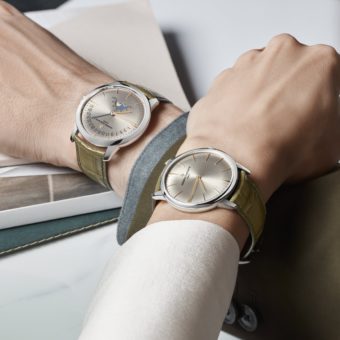
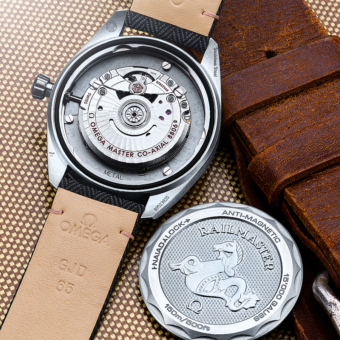
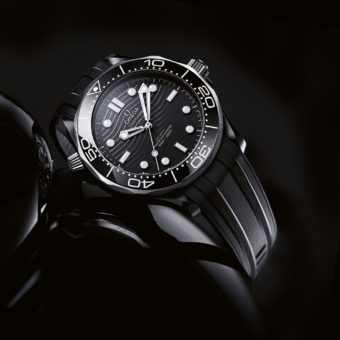
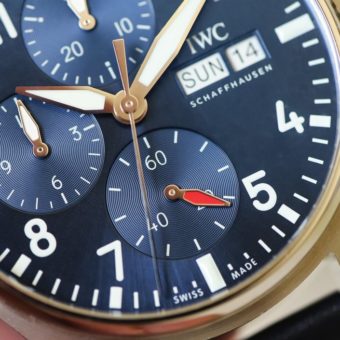
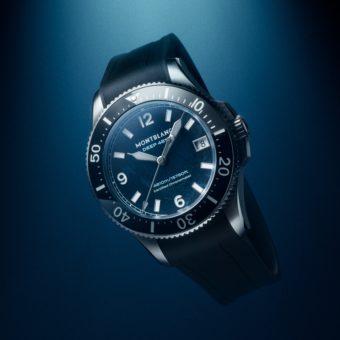
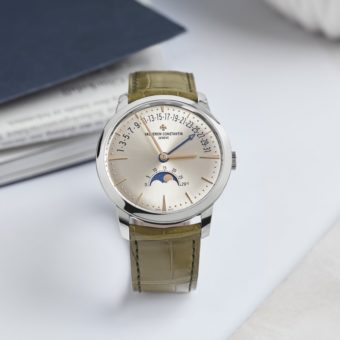
Is this an old review? The IWC TimeZoner model you are reviewing is not the current one…..
Both brands belong to Rchemont Group and as a watch collector I cannot see me buying any new watches produced by them. RG destroyed two iconic brands they own ( Panerai and IWC) by overproducing pieces that came with all sorts of problems and defects with a horrible post sales services. I love the classic Mont Blanc pens but I cannot see me ever buying a watch produced by them.
A second hand is not required to set a watch precisely. Simply pull the crown to stop the watch, adjust the minute hand to land directly over a minute marker and push in the crown in sync with a calibrated time hack just like you would if the second hand were stopped at the 12. The lack of a second hand does not make the watch less precise.
Hi there,
Why more watch designers/makers insist to have a multiple window for date? I only need to know the date on the day and “more or less” I can deduct the previous day’s date or the next day’s date.The multi number infested date indicator spoils the face of the watch.
Helps when the minute hand points to 15 minutes and covers the date. You can deduce the current date by seeing yesterday and tomorrow. Also looks cool…